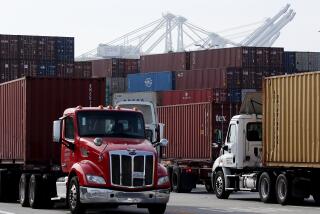Zero-emission gets overhaul
California’s Air Resources Board voted Thursday to slash by 70% the number of emission-free vehicles that carmakers must sell in the state in coming years, a significant blow for environmentalists and transportation activists.
But the panel set new rules requiring automakers to build tens of thousands of plug-in hybrid cars, which run on electricity and gasoline. And it adopted a motion to overhaul its entire Zero Emission Vehicle program to align it with tougher greenhouse-gas emission standards enacted in California in recent years. That could lead to the production of many more clean vehicles, but the overhaul won’t happen until at least the end of 2009.
Under the new standards, passed unanimously, the board will require the largest companies selling cars in the state to produce 7,500 electric and hydrogen fuel-cell vehicles for sale, lease or loan in California from 2012 to 2014 -- down from the 25,000 required in the period under the previous rules.
In addition, carmakers will be called upon to make about 58,000 plug-in hybrid electric vehicles in the same period. The previous regulation, passed in 2003, made no provisions for plug-in hybrids because they were not considered viable at the time.
“Clearly advocates would like to have more of these technologies available,” said air board member Daniel Sperling, who introduced the proposal that ultimately passed. “But it’s my view that both plug-in hybrids and [emission-free vehicles] are tremendous stretches for the industry.”
Environmental and transportation activists called the decision a victory for carmakers, which had lobbied vigorously against the mandates.
“It’s a huge blow,” said Chelsea Sexton, executive director of Plug In America, an advocacy group. “They sent the message to the carmakers that they can always get what they want from the board.”
Automakers, though, were reserved. “We’re going to have to take some time and study it,” Ford Motor Co. spokeswoman Jennifer Moore said. “The question is still what technology is ready and what is going to be commercially viable.”
Ford is one of six automakers -- along with General Motors Corp., Toyota Motor Corp., Chrysler, Honda Motor Co. and Nissan Motor Co. -- subject to the mandates. Smaller car companies are not bound by the rules, though they could be if their sales increase.
At the day’s outset, board Chairwoman Mary Nichols expressed a desire to increase the number of emission-free vehicles in California. “Our goal here today is to emerge with a clear direction that will get this program on track,” she said.
Yet the final decision was anything but clear. By inserting last-minute provisions that create a hierarchy among types of zero-emission vehicles, the number of such cars that automakers will have to make by 2014 could vary greatly.
If, for example, carmakers produce only hydrogen fuel-cell vehicles with an operational range of 300 miles or more, the number they would be required to make could be as few as 5,357 -- or 297 cars per automaker per year. If they make only short-range electric vehicles, though, the required number would jump to 12,500.
Created in 1990 with the intent to improve air quality, the ZEV mandate initially sought to require that 10% of all cars sold in the state be emission-free by 2004. ZEV has since been revised five times, and, after Thursday’s vote, will be again.
The latest plan to revise the mandate stems from the air board’s desire to align the program with a 2006 state law that sets a target of reducing greenhouse gas emissions 80% by 2050, and another law that calls for reducing tailpipe emissions of all cars sold in California.
“For 2015 and beyond, we’ll adopt a new program that will probably be even more aggressive than what is currently in effect,” board member Sperling said, without mentioning any specific numbers.
Ten other states have joined with California on the ZEV program, with the Golden State acting as sort of a lead regulator. However, the board previously granted automakers an exemption from having to make any ZEVs for the other participating states until 2011. On Thursday, the air board extended that date to 2017.
The board also adopted a provision requiring automakers to publicly disclose how many “credits” for producing emission-free vehicles they amass or trade with others.
The vote was preceded by hours of comments from automakers, activists and even a few high school students.
Former CIA Director R. James Woolsey, now a senior advisor at investment firm VantagePoint Venture Partners, called the issue of emission-free vehicles one of “national energy security” and asked the board to boost requirements for electric cars and plug-in hybrids. VantagePoint is an investor in plug-in hybrid maker Fisker Automotive Inc. Ze’ev Drori, chief executive of Tesla Motors Inc., maker of an electric car, argued for more rigorous standards. Because of the complicated workings of the mandate, his company stands to make money trading the credits it earns when it sells its vehicles.
“The only impediment to this is the parochial, self-interested agendas of the automakers,” he said.
Al Weverstad, executive director for environment, energy and safety at GM, asked the board for special consideration for the Chevy Volt, which is in development. GM says the car will have a longer range than rival plug-in hybrids.
“We’d ask that you give us some additional credits,” he said. The board granted that request, valuing extended-range plug-in hybrids above shorter-range models.
Robert Sawyer, former chairman of the air board, called for simplification. “We should return to a ‘zero means zero,’ simple, easy to enforce program,” he said.
--






